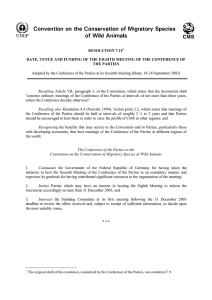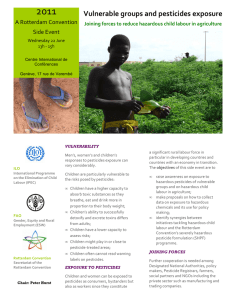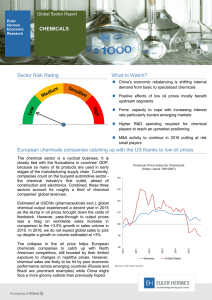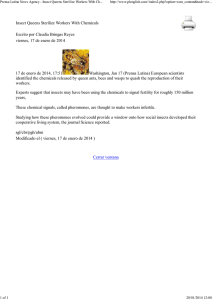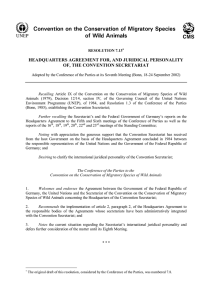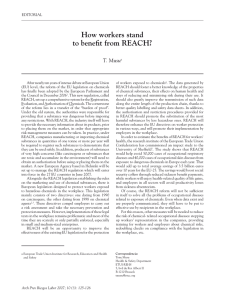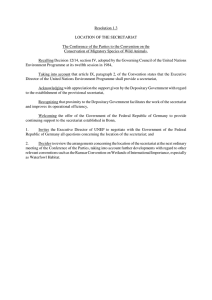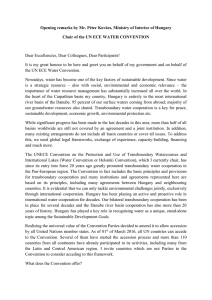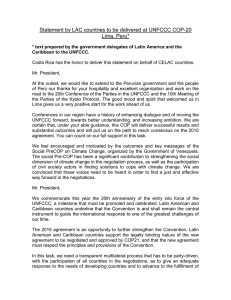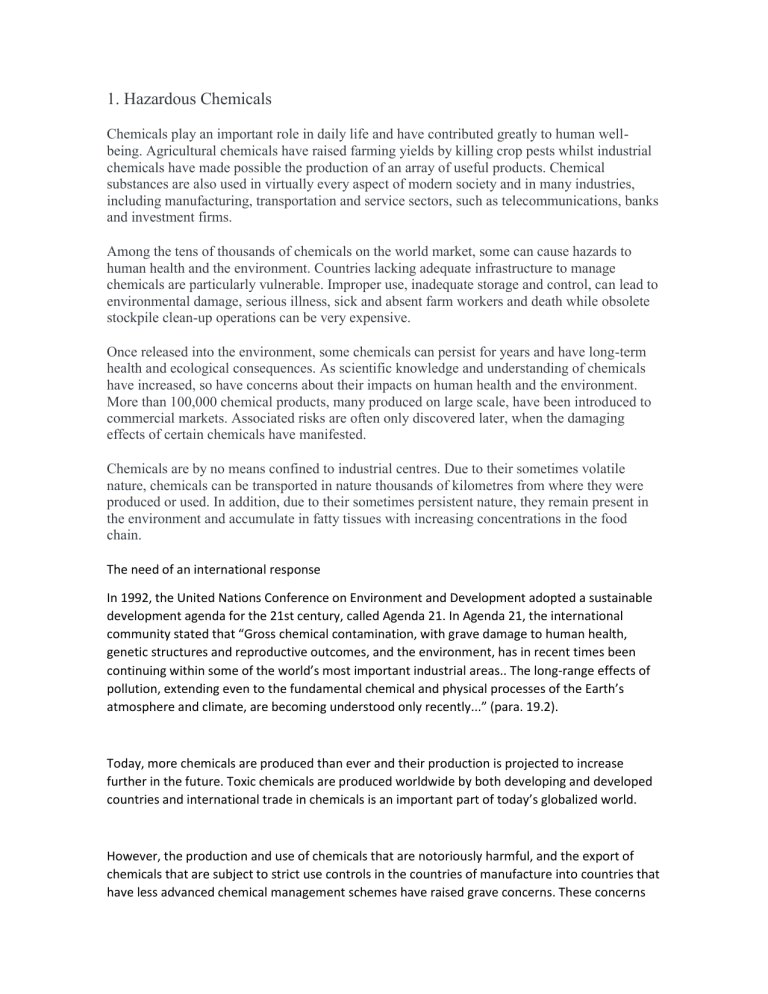
1. Hazardous Chemicals Chemicals play an important role in daily life and have contributed greatly to human wellbeing. Agricultural chemicals have raised farming yields by killing crop pests whilst industrial chemicals have made possible the production of an array of useful products. Chemical substances are also used in virtually every aspect of modern society and in many industries, including manufacturing, transportation and service sectors, such as telecommunications, banks and investment firms. Among the tens of thousands of chemicals on the world market, some can cause hazards to human health and the environment. Countries lacking adequate infrastructure to manage chemicals are particularly vulnerable. Improper use, inadequate storage and control, can lead to environmental damage, serious illness, sick and absent farm workers and death while obsolete stockpile clean-up operations can be very expensive. Once released into the environment, some chemicals can persist for years and have long-term health and ecological consequences. As scientific knowledge and understanding of chemicals have increased, so have concerns about their impacts on human health and the environment. More than 100,000 chemical products, many produced on large scale, have been introduced to commercial markets. Associated risks are often only discovered later, when the damaging effects of certain chemicals have manifested. Chemicals are by no means confined to industrial centres. Due to their sometimes volatile nature, chemicals can be transported in nature thousands of kilometres from where they were produced or used. In addition, due to their sometimes persistent nature, they remain present in the environment and accumulate in fatty tissues with increasing concentrations in the food chain. The need of an international response In 1992, the United Nations Conference on Environment and Development adopted a sustainable development agenda for the 21st century, called Agenda 21. In Agenda 21, the international community stated that “Gross chemical contamination, with grave damage to human health, genetic structures and reproductive outcomes, and the environment, has in recent times been continuing within some of the world’s most important industrial areas.. The long-range effects of pollution, extending even to the fundamental chemical and physical processes of the Earth’s atmosphere and climate, are becoming understood only recently...” (para. 19.2). Today, more chemicals are produced than ever and their production is projected to increase further in the future. Toxic chemicals are produced worldwide by both developing and developed countries and international trade in chemicals is an important part of today’s globalized world. However, the production and use of chemicals that are notoriously harmful, and the export of chemicals that are subject to strict use controls in the countries of manufacture into countries that have less advanced chemical management schemes have raised grave concerns. These concerns are particularly relevant to developing countries and countries with economies in transition, as they may be faced with chemicals without adequate information about their harmful impacts and without the infrastructure to manage them in an environmentally sound manner. Multilateral environmental agreements on hazardous chemicals The increase in production and use, including international trade, of potentially hazardous chemicals and their regional and global impacts stimulated multilateral cooperation in order to address emerging challenges, including through the conclusion of a number of multilateral environmental agreements. Early international efforts were generally devoted to improving the availability of information about chemical substances. In 1976 UNEP established the International Register of Potentially Toxic Chemicals (“IRPTC”) to compile and circulate information on chemical hazards. The 1985 International Code of Conduct on the Distribution and Use of Pesticides under the auspices of the FAO establishing voluntary standards for public and private entities. The London Guidelines for the Exchange of Information on Chemicals in International Trade were adopted by the Governing Council of UNEP in 1987 to increase chemical safety through the scientific, technical, economic and legal information exchange. In 1998 both these instruments were integrated into the Rotterdam Convention on the Prior Informed Consent Procedure for Certain Hazardous Chemicals and Pesticides in International Trade (“Rotterdam Convention”). The Vienna Convention for the Protection of the Ozone Layer (1985) and its Montreal Protocol (1987) provide control mechanisms for chemicals that deplete the ozone layer. The United Nations Framework Convention on Climate Change, adopted in 1992, and its Kyoto Protocol target substances known to cause global warming. A number of air pollutants are addressed by the UNECE Convention on Long-Range Transboundary Air Pollution and its protocols. The Convention concerning Safety in the Use of Chemicals at Work and the Convention concerning the Prevention of Major Industrial Accidents were concluded in 1990 and 1993 respectively under the auspices of the International Labour Organisation (ILO). The Stockholm Convention on Persistent Organic Pollutants (“Stockholm Convention), adopted in 2001, which aims at eliminating or reducing the release of persistent organic pollutants into the environment and the recently adopted Minamata Convention on Mercury (“Minamata Convention”) which regulates the anthropogenic releases of mercury throughout its lifecycle. 2. The origins of the Rotterdam Convention The dramatic growth in chemical production and trade since the 1970s has raised concerns about the potential risks posed by hazardous chemicals and pesticides. Countries lacking adequate infrastructure to monitor the import and use of these chemicals are particularly vulnerable. In response to these concerns, UNEP and FAO developed and promoted voluntary information exchange programmes in the mid-1980s. FAO launched the International Code of Conduct on the Distribution and Use of Pesticides in 1985 and UNEP established the London Guidelines for the Exchange of Information on Chemicals in International Trade in 1987. In 1989, the two organizations jointly introduced the voluntary Prior Informed Consent (PIC) procedure into these two instruments. Together, these instruments helped to ensure that governments had the necessary information to enable them to assess the risks of hazardous chemicals and to take informed decisions on their future import. Seeing the need for mandatory controls, officials attending the United Nations Conference on Environment and Development held in 1992 in Brazil (Rio Earth Summit) adopted Chapter 19 of Agenda 21, which called for a legally binding instrument on the voluntary PIC procedure by the year 2000. Consequently, the FAO Council (in 1994) and the UNEP Governing Council (in 1995) mandated their Executive Heads to launch negotiations. 2. The origins of the Rotterdam Convention The adoption of the Rotterdam Convention Talks started in March 1996 and concluded in March 1998, after a series of seven meetings of the Inter-Governmental Negotiation Committee and two years in advance of the deadline set by the Rio Earth Summit. The text of the Rotterdam Convention on the Prior Informed Consent Procedure for Certain Hazardous Chemicals and Pesticides in International Trade was adopted and opened for signature at the Conference of Plenipotentiaries held in Rotterdam on 10 September 1998. The Convention entered into force on 24 February 2004 and has, as at 1 March 2015, 154 Parties. 3. Overview The Rotterdam Convention provides Parties with a first line of defense against hazardous chemicals. It acts as an early warning system by: Facilitating information exchange on a broad range of chemicals that have been banned or severely restricted to protect human health or the environment in other countries; and Enabling countries to decide if they wish to allow imports of the hazardous chemicals and pesticides listed in Annex III of the Convention.. The Rotterdam Convention is not a recommendation to ban the global trade or use of specific chemicals. In case trade does take place, the Convention includes requirements for labelling and for the provision of information on potential health and environmental effects in order to promote the safe use of these chemicals. Trade under the Rotterdam Convention refers to the export and import of covered chemicals, as defined by article 2 paragraph (f): the movement of a chemical from one Party to another Party, the exclusion of mere transit operations. Objectives The objectives of the Rotterdam Convention are: to promote shared responsibility and cooperative efforts among Parties in the international trade of certain hazardous chemicals in order to protect human health and the environment from potential harm; to contribute to the environmentally sound use of those hazardous chemicals, by facilitating information exchange about their characteristics, by providing for a national decision-making process on their import and export and by disseminating these decisions to Parties. Scope The scope of the Convention is set out in its Article 3: the Convention applies to banned or severely restricted chemicals; and to severely hazardous pesticide formulations. A ‘chemical’ is defined in the Convention as “...a substance whether by itself or in a mixture or preparation and whether manufactured or obtained from nature, but does not include any living organism...” (Article 2). Annex III lists pesticides and industrial chemicals that are subject to the Convention’s prior informed consent (PIC) procedure. As at 1 March 2015, Annex III lists a total of 47 chemicals are listed in Annex III; 33 are pesticides, including 4 severely hazardous pesticide formulations, and are 14 industrial chemicals. At its seventh meeting in 2015, the Conference of the Parties will consider the inclusion of additional chemicals. Outside the scope of the Convention are certain chemicals that are regulated under other international regimes. These are narcotic drugs and psychotropic substances, radioactive materials, wastes, chemical weapons, chemicals used as food additives, and food. Chemicals in small quantities not likely to affect human health or the environment are also excluded, provided that they are imported for the purpose of research and analysis or by an individual for personal use. The Prior Informed Consent procedure The PIC procedure, along with information exchange, is one of the key provisions of the Rotterdam Convention. It consists of a mechanism for formally obtaining and disseminating the decisions of importing Parties as to whether they wish to receive future shipments of those chemicals listed in Annex III of the Convention and for ensuring compliance with these decisions by exporters. The PIC procedure only applies to the export and import of chemicals listed in Annex III. The Convention stipulates 2 key stages; (1) Import Responses and; (2) follow up Parties’ responsibilities. 1. Conference of the Parties Similarly to other MEAs, the Convention establishes a Conference of the Parties (COP) as its main governing body, whose functions are specified in its Article 18, for instance the authority to establish subsidiary bodies. The COP comprises representatives of all the parties to the Convention and it has decision-making power for matters under its purview. 2. Secretariat Under article 19 of the Convention, a Secretariat is established, with, among its functions, that of arranging and servicing meetings of Convention bodies, facilitating assistance to the Parties on request in the implementation of the Convention, and ensuring the necessary coordination with the secretariats of other relevant international bodies. The Secretariat functions are performed jointly by UNEP and the Food and Agriculture Organization (FAO). In 2012, a joint head was appointed to the Secretariat of the Basel Convention, the UNEP-part of the Secretariat of the Rotterdam Convention on Prior Informed Consent procedure for certain hazardous chemicals and pesticides in international trade, and the Secretariat of the Stockholm Convention on Persistent Organic Pollutants. This decision was made by the three meetings of the Conferences of the Parties in the context of the process of enhancing synergies among the three global hazardous chemicals and wastes conventions. 3. Subsidiary body - Chemical Review Committee At its first meeting, the Conference of the Parties established a subsidiary body, the Chemical Review Committee to review chemicals and pesticide formulations according to the criteria set out by the Convention and make recommendations to the Conference of the Parties for listing such chemicals in Annex III. 4. Non-compliance Since its first meeting, the Conference of the Parties has considered the development of procedures and institutional mechanism for determining non- compliance with the provisions of the Convention and for treatment of parties found to be in non-compliance. As mandated by article 17, these are to be adopted “as soon as practicable”.
